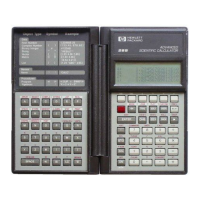HP-28S
CUSTOM Menu
General This displays the menu structure that has been created with the MENU
command, see below.
MENU Located in the MEMORY Menu.
• Takes a list of names and creates a custom menu containing these
names.
• The names need not refer to existing variables.
• The MENU command automatically activates the custom menu.
Custom
input menu
If the first name in the list passed to MENU is STO then a
custom input
menu
is created which is similar to the SOLV menu: Pressing a menu key
stores the element from stack level 1 in the specified variable.
The name STO is not included in the menu and the menu labels are
displayed in outlined mode instead of solid mode.
Custom
user menu
If the first name in the list passed to MENU is
not
STO then a custom user
menu is created which is similar to the regular USER menu. Notably, it can
be used to give access to variables, programs and directories.
CUSTOM Use this command (located on the USER key) to activate the custom menu.
Notes This is most useful in programs to generate a list of user choices.
Unfortunately, the VARS command (see MEMORY menu) does not return
the names in the CUSTOM menu when it is the active menu! Thus, it is not
possible for a program to save the contents of the current CUSTOM menu
and temporarily replace it by another customized menu.
But it is possible to write a modified MENU command which not only
creates a new CUSTOM menu but also stores the list of names in a global
variable for later reference:
<<DUP 'GLBCST' STO CUSTOM>> 'MENUS' STO
Integration
General
The integration symbol ∫ located on the "5" key can be used to integrate
arbitrary functions numerically or polynomials (sums of powers of x)
symbolically.
Symbolic
integration
Example: 'x^3+2*x+5' 'x' 3 ∫ returns '5*x + x^2 + 0.25*x^4'
• Stack level 3 contains the polynomial to integrate (or the variable where
it is stored).
• Level 2 contains the integration variables
• Level 1 contains the degree of the polynomial to integrate
Numeric
integration
with explicit
integration
variable
Example: 'EXP(x)+5' {'x' 1 2} 1E-3 ∫ returns 9.67 0.01:
• Stack level 3 contains the function to integrate.
The function result must be a real value.
• Stack level 2 contains a list which specifies: The integration variable
and the lower and upper limits of integration. The limits of integration
must be real values.
• Stack level 1 contains the desired absolute accuracy of the result.
• The result after integration is 9.67… in stack level 2.
• 9.669…E-3 in stack level 1 is the upper limit for the relative error. The
absolute error is 9.669…E-3/9.67…=9.998…E-4 which is indeed better
43

